Ali Vosoughi
Caption Anything in Video: Fine-grained Object-centric Captioning via Spatiotemporal Multimodal Prompting
Apr 09, 2025Abstract:We present CAT-V (Caption AnyThing in Video), a training-free framework for fine-grained object-centric video captioning that enables detailed descriptions of user-selected objects through time. CAT-V integrates three key components: a Segmenter based on SAMURAI for precise object segmentation across frames, a Temporal Analyzer powered by TRACE-Uni for accurate event boundary detection and temporal analysis, and a Captioner using InternVL-2.5 for generating detailed object-centric descriptions. Through spatiotemporal visual prompts and chain-of-thought reasoning, our framework generates detailed, temporally-aware descriptions of objects' attributes, actions, statuses, interactions, and environmental contexts without requiring additional training data. CAT-V supports flexible user interactions through various visual prompts (points, bounding boxes, and irregular regions) and maintains temporal sensitivity by tracking object states and interactions across different time segments. Our approach addresses limitations of existing video captioning methods, which either produce overly abstract descriptions or lack object-level precision, enabling fine-grained, object-specific descriptions while maintaining temporal coherence and spatial accuracy. The GitHub repository for this project is available at https://github.com/yunlong10/CAT-V
VERIFY: A Benchmark of Visual Explanation and Reasoning for Investigating Multimodal Reasoning Fidelity
Mar 14, 2025Abstract:Visual reasoning is central to human cognition, enabling individuals to interpret and abstractly understand their environment. Although recent Multimodal Large Language Models (MLLMs) have demonstrated impressive performance across language and vision-language tasks, existing benchmarks primarily measure recognition-based skills and inadequately assess true visual reasoning capabilities. To bridge this critical gap, we introduce VERIFY, a benchmark explicitly designed to isolate and rigorously evaluate the visual reasoning capabilities of state-of-the-art MLLMs. VERIFY compels models to reason primarily from visual information, providing minimal textual context to reduce reliance on domain-specific knowledge and linguistic biases. Each problem is accompanied by a human-annotated reasoning path, making it the first to provide in-depth evaluation of model decision-making processes. Additionally, we propose novel metrics that assess visual reasoning fidelity beyond mere accuracy, highlighting critical imbalances in current model reasoning patterns. Our comprehensive benchmarking of leading MLLMs uncovers significant limitations, underscoring the need for a balanced and holistic approach to both perception and reasoning. For more teaser and testing, visit our project page (https://verify-eqh.pages.dev/).
Quality Over Quantity? LLM-Based Curation for a Data-Efficient Audio-Video Foundation Model
Mar 12, 2025Abstract:Integrating audio and visual data for training multimodal foundational models remains challenging. We present Audio-Video Vector Alignment (AVVA), which aligns audiovisual (AV) scene content beyond mere temporal synchronization via a Large Language Model (LLM)-based data curation pipeline. Specifically, AVVA scores and selects high-quality training clips using Whisper (speech-based audio foundation model) for audio and DINOv2 for video within a dual-encoder contrastive learning framework. Evaluations on AudioCaps, VALOR, and VGGSound demonstrate that this approach can achieve significant accuracy gains with substantially less curated data. For instance, AVVA yields a 7.6% improvement in top-1 accuracy for audio-to-video retrieval on VGGSound compared to ImageBind, despite training on only 192 hours of carefully filtered data (vs. 5800+ hours). Moreover, an ablation study highlights that trading data quantity for data quality improves performance, yielding respective top-3 accuracy increases of 47.8, 48.4, and 58.0 percentage points on AudioCaps, VALOR, and VGGSound over uncurated baselines. While these results underscore AVVA's data efficiency, we also discuss the overhead of LLM-driven curation and how it may be scaled or approximated in larger domains. Overall, AVVA provides a viable path toward more robust, text-free audiovisual learning with improved retrieval accuracy.
Enhancing Graph Attention Neural Network Performance for Marijuana Consumption Classification through Large-scale Augmented Granger Causality (lsAGC) Analysis of Functional MR Images
Oct 24, 2024Abstract:In the present research, the effectiveness of large-scale Augmented Granger Causality (lsAGC) as a tool for gauging brain network connectivity was examined to differentiate between marijuana users and typical controls by utilizing resting-state functional Magnetic Resonance Imaging (fMRI). The relationship between marijuana consumption and alterations in brain network connectivity is a recognized fact in scientific literature. This study probes how lsAGC can accurately discern these changes. The technique used integrates dimension reduction with the augmentation of source time-series in a model that predicts time-series, which helps in estimating the directed causal relationships among fMRI time-series. As a multivariate approach, lsAGC uncovers the connection of the inherent dynamic system while considering all other time-series. A dataset of 60 adults with an ADHD diagnosis during childhood, drawn from the Addiction Connectome Preprocessed Initiative (ACPI), was used in the study. The brain connections assessed by lsAGC were utilized as classification attributes. A Graph Attention Neural Network (GAT) was chosen to carry out the classification task, particularly for its ability to harness graph-based data and recognize intricate interactions between brain regions, making it appropriate for fMRI-based brain connectivity data. The performance was analyzed using a five-fold cross-validation system. The average accuracy achieved by the correlation coefficient method was roughly 52.98%, with a 1.65 standard deviation, whereas the lsAGC approach yielded an average accuracy of 61.47%, with a standard deviation of 1.44. The suggested method enhances the body of knowledge in the field of neuroimaging-based classification and emphasizes the necessity to consider directed causal connections in brain network connectivity analysis when studying marijuana's effects on the brain.
EAGLE: Egocentric AGgregated Language-video Engine
Sep 26, 2024



Abstract:The rapid evolution of egocentric video analysis brings new insights into understanding human activities and intentions from a first-person perspective. Despite this progress, the fragmentation in tasks like action recognition, procedure learning, and moment retrieval, \etc, coupled with inconsistent annotations and isolated model development, hinders a holistic interpretation of video content. In response, we introduce the EAGLE (Egocentric AGgregated Language-video Engine) model and the EAGLE-400K dataset to provide a unified framework that integrates various egocentric video understanding tasks. EAGLE-400K, the \textit{first} large-scale instruction-tuning dataset tailored for egocentric video, features 400K diverse samples to enhance a broad spectrum of tasks from activity recognition to procedure knowledge learning. Moreover, EAGLE, a strong video multimodal large language model (MLLM), is designed to effectively capture both spatial and temporal information. In addition, we propose a set of evaluation metrics designed to facilitate a thorough assessment of MLLM for egocentric video understanding. Our extensive experiments demonstrate EAGLE's superior performance over existing models, highlighting its ability to balance task-specific understanding with holistic video interpretation. With EAGLE, we aim to pave the way for research opportunities and practical applications in real-world scenarios.
OSCaR: Object State Captioning and State Change Representation
Feb 28, 2024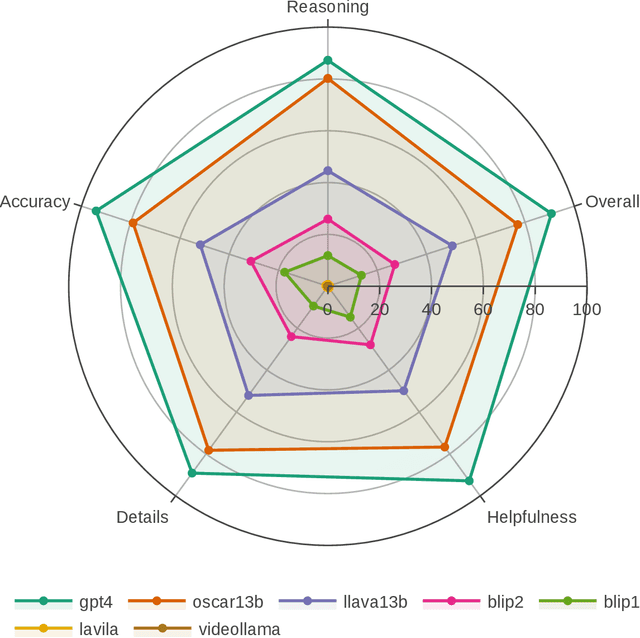

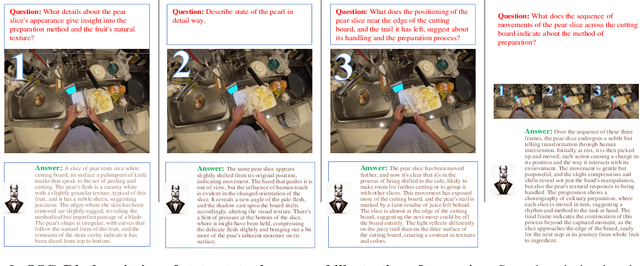
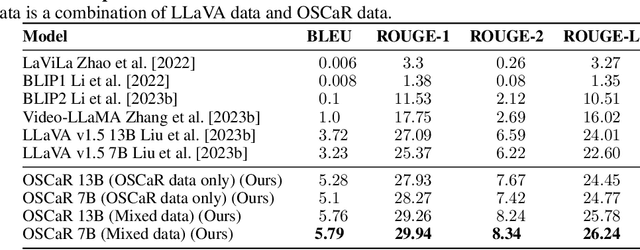
Abstract:The capability of intelligent models to extrapolate and comprehend changes in object states is a crucial yet demanding aspect of AI research, particularly through the lens of human interaction in real-world settings. This task involves describing complex visual environments, identifying active objects, and interpreting their changes as conveyed through language. Traditional methods, which isolate object captioning and state change detection, offer a limited view of dynamic environments. Moreover, relying on a small set of symbolic words to represent changes has restricted the expressiveness of language. To address these challenges, in this paper, we introduce the Object State Captioning and State Change Representation (OSCaR) dataset and benchmark. OSCaR consists of 14,084 annotated video segments with nearly 1,000 unique objects from various egocentric video collections. It sets a new testbed for evaluating multimodal large language models (MLLMs). Our experiments demonstrate that while MLLMs show some skill, they lack a full understanding of object state changes. The benchmark includes a fine-tuned model that, despite initial capabilities, requires significant improvements in accuracy and generalization ability for effective understanding of these changes. Our code and dataset are available at https://github.com/nguyennm1024/OSCaR.
Learning Audio Concepts from Counterfactual Natural Language
Jan 10, 2024Abstract:Conventional audio classification relied on predefined classes, lacking the ability to learn from free-form text. Recent methods unlock learning joint audio-text embeddings from raw audio-text pairs describing audio in natural language. Despite recent advancements, there is little exploration of systematic methods to train models for recognizing sound events and sources in alternative scenarios, such as distinguishing fireworks from gunshots at outdoor events in similar situations. This study introduces causal reasoning and counterfactual analysis in the audio domain. We use counterfactual instances and include them in our model across different aspects. Our model considers acoustic characteristics and sound source information from human-annotated reference texts. To validate the effectiveness of our model, we conducted pre-training utilizing multiple audio captioning datasets. We then evaluate with several common downstream tasks, demonstrating the merits of the proposed method as one of the first works leveraging counterfactual information in audio domain. Specifically, the top-1 accuracy in open-ended language-based audio retrieval task increased by more than 43%.
Video Understanding with Large Language Models: A Survey
Jan 04, 2024


Abstract:With the burgeoning growth of online video platforms and the escalating volume of video content, the demand for proficient video understanding tools has intensified markedly. Given the remarkable capabilities of Large Language Models (LLMs) in language and multimodal tasks, this survey provides a detailed overview of the recent advancements in video understanding harnessing the power of LLMs (Vid-LLMs). The emergent capabilities of Vid-LLMs are surprisingly advanced, particularly their ability for open-ended spatial-temporal reasoning combined with commonsense knowledge, suggesting a promising path for future video understanding. We examine the unique characteristics and capabilities of Vid-LLMs, categorizing the approaches into four main types: LLM-based Video Agents, Vid-LLMs Pretraining, Vid-LLMs Instruction Tuning, and Hybrid Methods. Furthermore, this survey presents a comprehensive study of the tasks, datasets, and evaluation methodologies for Vid-LLMs. Additionally, it explores the expansive applications of Vid-LLMs across various domains, highlighting their remarkable scalability and versatility in real-world video understanding challenges. Finally, it summarizes the limitations of existing Vid-LLMs and outlines directions for future research. For more information, readers are recommended to visit the repository at https://github.com/yunlong10/Awesome-LLMs-for-Video-Understanding.
Separating Invisible Sounds Toward Universal Audiovisual Scene-Aware Sound Separation
Oct 18, 2023



Abstract:The audio-visual sound separation field assumes visible sources in videos, but this excludes invisible sounds beyond the camera's view. Current methods struggle with such sounds lacking visible cues. This paper introduces a novel "Audio-Visual Scene-Aware Separation" (AVSA-Sep) framework. It includes a semantic parser for visible and invisible sounds and a separator for scene-informed separation. AVSA-Sep successfully separates both sound types, with joint training and cross-modal alignment enhancing effectiveness.
MISAR: A Multimodal Instructional System with Augmented Reality
Oct 18, 2023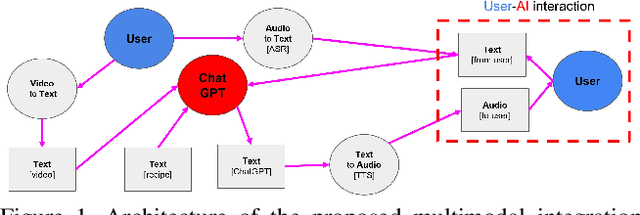
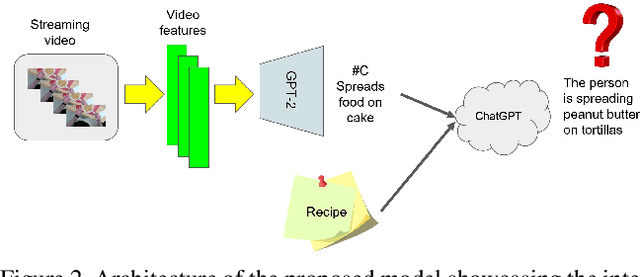

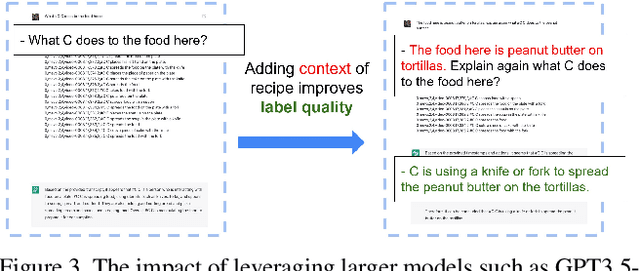
Abstract:Augmented reality (AR) requires the seamless integration of visual, auditory, and linguistic channels for optimized human-computer interaction. While auditory and visual inputs facilitate real-time and contextual user guidance, the potential of large language models (LLMs) in this landscape remains largely untapped. Our study introduces an innovative method harnessing LLMs to assimilate information from visual, auditory, and contextual modalities. Focusing on the unique challenge of task performance quantification in AR, we utilize egocentric video, speech, and context analysis. The integration of LLMs facilitates enhanced state estimation, marking a step towards more adaptive AR systems. Code, dataset, and demo will be available at https://github.com/nguyennm1024/misar.
 Add to Chrome
Add to Chrome Add to Firefox
Add to Firefox Add to Edge
Add to Edge